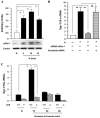Receptor for AGE (RAGE): signaling mechanisms in the pathogenesis of diabetes and its complications
- PMID: 22211895
- PMCID: PMC4501013
- DOI: 10.1111/j.1749-6632.2011.06320.x
Receptor for AGE (RAGE): signaling mechanisms in the pathogenesis of diabetes and its complications
Abstract
The receptor for advanced glycation endproducts (RAGE) was first described as a signal transduction receptor for advanced glycation endproducts (AGEs), the products of nonenzymatic glycation and oxidation of proteins and lipids that accumulate in diabetes and in inflammatory foci. The discovery that RAGE was a receptor for inflammatory S100/calgranulins and high mobility group box 1 (HMGB1) set the stage for linking RAGE to both the consequences and causes of types 1 and 2 diabetes. Recent discoveries regarding the structure of RAGE as well as novel intracellular binding partner interactions advance our understanding of the mechanisms by which RAGE evokes pathological consequences and underscore strategies by which antagonism of RAGE in the clinic may be realized. Finally, recent data tracking RAGE in the clinic suggest that levels of soluble RAGEs and polymorphisms in the gene encoding RAGE may hold promise for the identification of patients who are vulnerable to the complications of diabetes and/or are receptive to therapeutic interventions designed to prevent and reverse the damage inflicted by chronic hyperglycemia, irrespective of its etiology.
© 2011 New York Academy of Sciences.
Figures



References
-
- Forlenza GP, Paradise Black NM, McNamara EG, Sullivan SE. Ankyloglossia, exclusive breastfeeding, and failure to thrive. Pediatrics. 2010;125:e1500–e1504. - PubMed
-
- Peng H, Hagopian W. Environmental factors in the development of Type 1 diabetes. Rev. Endocr. Metab. Disord. 2006;7:149–162. - PubMed
-
- International Diabetes Federation IDF Diabetes Atlas. Epidemiology and Morbidity. International Diabetes Federation. Available from: http://www.idf.org.
-
- Sweat V, Bruzzese JM, Albert S, et al. The Banishing Obesity and Diabetes in Youth (BODY) Project: description and feasibility of a program to halt obesity-associated disease among urban high school students. J. Community Health. 2011 In press. - PubMed
Publication types
MeSH terms
Substances
Grants and funding
LinkOut - more resources
Full Text Sources
Other Literature Sources
Medical

